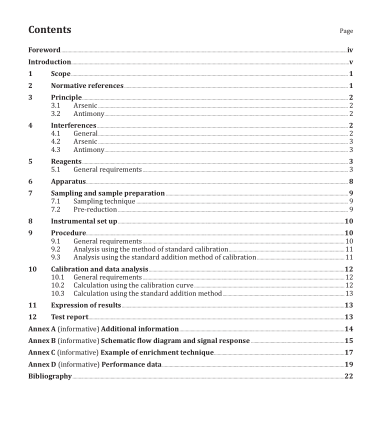ISO 17378-2:2014 pdf download.Water quality — Determination of arsenic and antimony — Part 2: Method using hydride generation atomic absorption spectrometry (HG- AAS)
3 Principle
NOTE Other measurement techniques can be applicable providing the performance criteria are adequately demonstrated to be fulfilled or exceeded by the user laboratory. (See Annex C.)
3.1 Arsenic
An aliquot of sample is acidified with hydrochloric acid (5.3). Potassium iodide–ascorbic acid reagent (5.9) is added to ensure quantified reduction of arsenic(V) to arsenic(III). The sample solutions are treated with sodium tetrahydroborate (5.5) to generate the covalent gaseous arsenic trihydride (arsine, AsH 3 ). The hydride and excess hydrogen are swept out of the generation vessel in case of batch mode and out of the gas/liquid separator in case of the continuous mode into a heated silica cell. After atomization, the absorbance of arsenic is determined at a wavelength λ = 193,7 nm. The procedure is automated by means of auto-sampler and control software.
3.2 Antimony
An aliquot of sample is digested with hydrochloric acid (5.3). Potassium iodide–ascorbic acid reagent (5.9) is added to ensure quantified reduction of the antimony(V) to antimony(III). The sample solutions are then treated with sodium tetrahydroborate (5.5) to generate the covalent gaseous antimony trihydride (stibane, SbH 3 ).
The hydride and excess hydrogen are swept out of the generation vessel in case of batch mode and out of the gas/liquid separator in case of continuous mode. After atomization, the absorbance of antimony is determined at a wavelength λ = 217,6 nm. The procedure is automated by means of auto-sampler and control software.
4 Interferences
4.1 General The hydride generation technique is prone to interferences by transition and easily reducible metals.
For the majority of natural water samples, this type of interference shall not be significant. The user should carry out recovery tests on typical waters and also determine the maximum concentrations of potentially interfering elements, using appropriate methods. If such interferences are indicated, the level of interferences should be assessed by performing spike recoveries. Metals which are readily reduced by sodium tetrahydroborate may also cause interferences. In particular, these include chromium, iron, copper, nickel, and lead. If the concentrations of these elements specified in Table 1 are exceeded, a significant decrease of absorption may occur.
4.2 Arsenic
Elements such as antimony, selenium, tellurium, mercury, and tin are also volatilized by this procedure and may cause interferences. These elements do not cause interferences providing the concentrations specified in Table 2 are not exceeded.
5 Reagents
5.1 General requirements
It is important to use high purity reagents in all cases with minimum levels of arsenic or antimony.
Reagents may contain arsenic or antimony as an impurity. All reagents shall have arsenic or antimony concentrations below that which would result in an arsenic or antimony blank value for the method being above the lowest level of interest.
Use only reagents of recognized analytical grade, unless otherwise specified.
Reagents shall be prepared to manufacturer’s recommendations using the following series as an example.
5.2 Water, complying with grade 1 as defined in ISO 3696, for all sample preparation and dilutions.
5.3 Hydrochloric acid, ρ(HCl) = 1,16 g/ml.
5.4 Hydrochloric acid, c(HCl) = 1 mol/l.
5.5 Sodium tetrahydroborate, NaBH 4 .
Available as pellets. Keep the pellets dry and store in a cool, dark place.
5.6 Sodium hydroxide, NaOH.
5.7 Sodium tetrahydroborate solution, ρ(NaBH 4 ) = 13 g/l.
Prepare appropriate quantities on day of use (13 g/l has proven suitable for the system illustrated in Figure B.1).
Dissolve 0,4 g sodium hydroxide (5.6) and the appropriate quantity of sodium tetrahydroborate (5.5) in 800 ml of water and dilute to 1 000 ml.
Do not keep in a closed container because of potential pressure build-up due to hydrogen evolution.
Excess sodium borohydride solution should be slowly poured to drain with copious quantities of water.
Do not allow the solution to come into contact with acid during disposal.
NOTE The concentration of NaBH 4 is dependent on the hybride generator manifold and flow-rate conditions.
See recommendations of the manufacturer.
Alternatively smaller volumes can be prepared on a pro rata basis.
5.8 Nitric acid, ρ(HNO 3 ) = 1,40 g/ml.
NOTE Nitric acid is available both as ρ(HNO 3 ) = 1,40 g/ml [w(HNO 3 ) = 650 g/kg] and ρ(HNO 3 ) = 1,42 g/ml [w(HNO 3 ) = 690 g/kg].
To prepare a nitric acid cleaning mixture, dilute nitric acid (1,40 g/ml) with an equal volume of water (5.2) by carefully adding the acid to the water.
5.9 Potassium iodide–ascorbic acid solution.
Dissolve (250 ± 0,1) g of potassium iodide (KI) and (50 ± 0,1) g of ascorbic acid (C 6 H 8 O 6 ) in approximately 400 ml water and dilute to 500 ml.
Prepare freshly on day of use. See Note to (5.7).ISO 17378-2 pdf download.ISO 17378-2 pdf download
